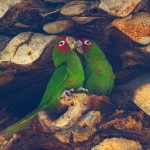Yellow Chevroned Parakeets (Brotogeris chiriri)
The smallest of all California’s naturalized parrots, the Yellow Chevroned Parakeets (Brotogeris Chiriri) are always fast paced and on the go. These birds feed on numerous exotic seeds, flower nectar, or even large Silk Floss fruits (Chorisia Speciosa) that may even dwarf them in size. Unique calls and soft chirps are easily heard as they are often seen bickering among each other in neighborhood trees. They are the closest naturalized relative to the Monk Parakeet which resides in our eastern states.

Mitred Conures or Parakeets (Psittacara mitrata)
These are California’s largest, most abundant, and widespread of California’s Conure or Aratinga species. These boisterous and colorful birds can be found in over thirty California cities but generally keep their flock numbers to below fifty individuals. They are California’s closest naturalized relative to the giant Macaws of Latin America.

Blue Crowned Conure or Parakeets (Thectocercus acuticaudatus)
Quite possibly the rarest among the California’s parrot flocks, these easily identified yet rarely seen parrots exist in small pockets of a few well distanced California cities where flock numbers rarely exceed ten individuals. They are identified by their softer, shrill like calls and unique appearances as well.
Indian Ringneck Parrots (Psittacula krameri)
California’s only old world parrot flock species can be easily be distinguished between sexes as adult males are seen exhibiting prominent colors and they famous ringed collared neck. Although frequently encountered in central cities such as Bakersfield, smaller populations have been documented in Southern California as well.
Nanday Conures or Black Hooded Parakeets (Nandayus nenday)
These strikingly unique parrots are well known inhabitants of cities such as Malibu and Augora Hills. They’re also familiar faces to residents with bird feeders as well. They have simple, easily identified calls which can at times be heard echoing through Canyon sides as well.
Yellow head Amazons (Amazona oratrix)
The largest of the California’s parrots, Yellow head flocks are among the smallest in population. As sightings of these majestic parrots were recorded as early as mid-seventies in former cities such as Santa Monica, today’s sightings are very limited and restricted to small pockets within a few cities. There are quite possibly only two current active and distant flocks of these parrots in California, in addition to a handful of other individuals sporadically scattered among other Amazon flocks.
Blue Fronted Amazons (Amazona aestiva)
Among the most secretive and elusive, the Blue Fronted Amazons may be identified by their distinct and diverse calls. The majority of these existing parrots are currently hybrids which have occurred from mating with the similar looking Yellow head Amazons. However although rare, hybridized offspring with Red Lored Amazons has also been documented. These beautiful giants are at times seen accompanying Yellow head flocks while adopting their calls as well.
Lilac Crowned Amazons (Amazona finschi)
Also known as Finsch’s Amazon, these beautiful cousins of our Green Cheeked Amazons are fairly common in many cities. Like the Green cheeked Amazons, they are also endangered in their homelands and have also proven to maintain strong stability in population numbers within several California cities.
Green Cheeked Amazon(Amazona viridigenalis)
Green Cheeked Amazons are also referred to as Mexican Red Head parrots or Red Crowned Amazons. They are the most abundant naturalized parrots of California. They are also endangered in their native Mexico due to smugglers and deforestation.
Red Masked Conures or Parakeets (Psittacara erythrogenys)
Also referred to as Cherry Headed Conures, these birds are quite famous in cities such as San Francisco. Though quite similar in appearance to the larger Mitred Conures, they are distinguishable from their larger cousins by exhibiting vibrantly colored red faces, red wing undersides and producing softer calls. These parrots can be observed sharing nest sites with the larger Mitreds while in some cities hybridization may also occur between these two species. Despite hybridization, established unmixed flocks of this species are quite abundant in various cities.
Red Lored Amazons (Amazona autumnalus)
These colorful parrots are also referred to as Yellow Cheeked Amazons. Red Lored Amazons have established flocks in several California cities. They are the third largest California parrot species and may slightly resemble Green Cheeked Amazons. Unlike Green Cheeked Amazons, these parrots exhibit a more reserved side appearing more wary of human presence and producing softer and higher pitched whistles in their calls.
White Fronted Amazons (Amazona albifrons)
White Fronted Amazons are also referred to as spectacled Amazons in Aviculture. They are the smallest of California’s Amazon parrots. Like our Blue Fronted Amazons, the majority of their remaining population consist of identified hybrids. White Fronted Amazons are sporadically yet widely found in various counties throughout southern California usually accompanying large mixed Amazon flocks.
